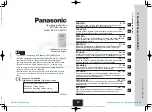
Trigno Quattro, Duo, Mini EMG Sensor User’s Guide
7
Trigno System Overview
The Trigno
®
Quattro, Duo and Mini Sensors are components of the Trigno
Wireless Biofeedback System, a device designed to make EMG
(electromyographic) and biofeedback signal detection reliable and easy. The
system transmits signals from the Trigno sensors to a receiving base station
using a time-synchronized wireless protocol which minimizes data latency
across sensors. The core architecture of the Trigno System is designed to
support high fidelity EMG signals, along with complementary biofeedback
signals such as movement data, force signals, contact pressure events and
timing and triggering information. For mobile biofeedback applications, Trigno
Sensors can communicate with Bluetooth BLE 4.2 compliant host devices. The
system is also capable of integrating with 3rd party lab equipment through a
variety of interfaces which include analog signal generation, triggering
scenarios and digital integration through the Trigno SDK (Software
Development Kit) and the Trigno API (Application Program Interface).
Refer to
the Trigno System User Guide for System information and operational details.
Trigno Quattro, Duo and Mini Sensor Features
The Trigno family of minihead sensors are capable of detecting four (“Quattro”),
two (“Duo”) or one (“Mini”) EMG signals with each head. Each Sensor is
equipped with the following capabilities and design features:
•
Configurable bandwidth 20-450 Hz or 10 – 850Hz
•
built-in 9-axis inertial measurement unit (IMU)
•
onboard RMS and Mean calculations
•
onboard orientation calculation
•
software selectable operational modes
•
inter-sensor latency < 1 sample period
•
wireless transmission range 20+m
•
self-contained rechargeable battery
•
battery charge monitoring and status indicator
•
environmentally sealed enclosure
•
low power mode
•
auto shutoff
•
internal magnetic switch
•
LED User Feedback
•
Four EMG detection locations (“Quattro”)
•
Two EMG detection locations (“Duo”)
•
One EMG detection location (“Mini”)
1. Communication distance is dependent on the RF operating environment.
Qu
at
tr
o
Du
o
M
in
i








































